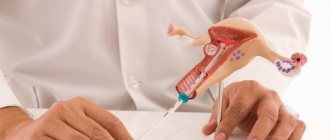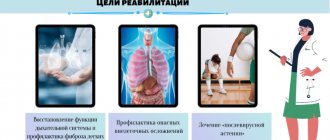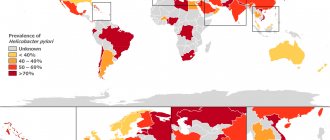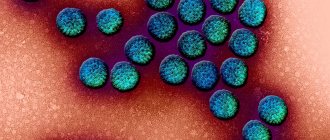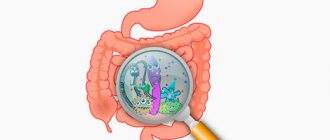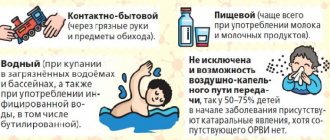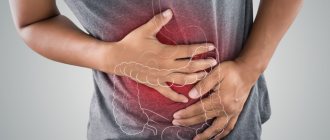Detailed description of the study
Rotavirus is one of the most common pathogens of intestinal infections. This virus received its name from the word “rota”, which in Latin means “wheel” due to the similarity with this object when studying the structure of the pathogen under a microscope.
In temperate climates, rotavirus infection is seasonal; Its frequency peaks in the winter months; in summer, the disease is detected infrequently. The source of infection is usually an infected person. Transmission occurs through the fecal-oral route, sometimes through contact, for example, when using shared utensils, other household items, and toys.
The incubation period lasts on average 1-2 days. The virus penetrates the intestinal cells - enterocytes, and multiplies there. Damage to enterocytes leads to their death, which impairs the absorption of nutrients and fluids in the body and determines the development of the main symptoms of gastroenteritis.
The disease can begin acutely with damage to the gastrointestinal tract or gradually, which is less common. In the first case, nausea, vomiting, and watery diarrhea immediately appear up to 20 times a day. The stool is yellow, foamy, and has a strong unpleasant odor. Sometimes it contains mucus.
In addition, there are spastic pains in the umbilical region and lower abdomen, and a moderate increase in body temperature (usually not higher than 38 ° C). Fever usually lasts up to 2 days. The gradual onset of rotavirus infection implies the appearance of general malaise and abdominal pain, which is accompanied by vomiting and diarrhea on the 2-3rd day of illness.
On average, the disease lasts from 4 to 8 days. Certain components of rotavirus are recognized by the immune system as a foreign substance - an antigen. As a result, antibodies are produced that destroy the virus. Due to the wide variety of rotaviruses and unstable immunity to these pathogens, the body fails to develop long-term immune protection, and re-infection is possible.
Along with the classic manifestations of rotavirus infection, erased and atypical forms are distinguished, when the disease manifests itself only by fever and nausea or only diarrhea. A person can shed the virus for some time after symptoms disappear.
Children 6 months to 2 years of age and people with weakened immune systems are especially susceptible to the virus. They can develop severe dehydration (dehydration) in a fairly short period of time, which is life-threatening.
Rapid and accurate detection of rotavirus antigens in stool samples helps to understand the cause of gastroenteritis.
What is a test for rotavirus infection?
To determine gastroenteritis, a stool test is required.
Conditions:
- feces are not collected after the enema;
- do not use after using suppositories;
- the use of laxatives is prohibited before donating feces;
- Contact of collected material with urine and toilet bowl is prohibited.
The material is placed in sterile packaging. Use 3-4 grams of feces to determine the disease. Buy the packaging or container at the pharmacy.
In infants, feces are collected from the diaper. It is permissible to store the container in the refrigerator for several hours.
The study determines the rotavirus VP6 antigen. In the absence of intestinal flu - a negative result; if bacteria are present in the stool, the result will be positive.
The test for rotavirus infection is allowed to be false positive, false negative - then the analysis is repeated. They come back the next day for the results.
The infection in question is diagnosed by electron microscopy. Intestinal flu is detected at the initial stage. The technique will help detect the rotavirus strain.
Rotavirus strains
Diagnostics are expensive, and most medical institutions do not have the necessary equipment to test samples.
Electron microscopy is used in laboratories conducting scientific research.
Following the rules of personal hygiene will help prevent rotavirus infection.
Instant analysis is done using a rapid test at home.
Preparing for analysis
For diagnostics:
- remove the cap from the dropper;
- take a stick to collect stool;
- close the dropper bottle with feces and solvent;
- shake the container to dissolve the tests;
- You will need medical gloves, a watch, a bottle.
Follow the requirements:
- diagnosis is carried out by bringing the test device and stool to room temperature;
- Do not open the test package until testing is completed;
- shake the container to break down the tests, cut off the tip of the bottle cap;
- use a separate container for stool samples, apply 5 drops to the round window marked with an arrow;
- see the test result after 10-15 minutes (colored stripes will appear):
- If the test is negative, a green stripe appears in the central sector with the letter C (control line).
- If positive, a green and red line appears, marked with the letter T (test line for intestinal flu).
- Adenovirus test - in addition to the green line, a blue line appears (test line for adenovirus) in sector T (result).
- Rotavirus-adenovirus is positive - simultaneous appearance of the listed bands.
- Failed test: no green stripe. Reasons: non-compliance with the sample volume, analysis technique was violated, reagents were damaged.
Restrictions:
- the express test is carried out no more than 2 hours after opening the package;
- with a large amount of sample, an incorrect test result is allowed (the appearance of brown lines);
- the rota test is carried out no more than a week after the onset of symptoms - the number of parasites decreases every day;
- a rapid test determines the presumptive result. For an accurate determination, consult a doctor and conduct a set of laboratory tests.
Differential diagnosis
These methods make it possible to distinguish rotavirus infection from diseases with similar characteristics:
- salmonellosis;
- cholera;
- dysentery;
- food poisoning.
The following factors are taken into account:
- With salmonella there is no hyperemia of the pharyngeal mucosa.
- Cholera is much more severe.
- Dysentery gives an almost accurate picture of rotavirus.
To make a correct diagnosis, tests are performed for the presence of bacteria and parasites.
Prices
The cost of procedures varies depending on the region, as well as the type of medical center. In municipal clinics, manipulations are performed free of charge. In private you need to “fork out”:
- A blood test for rotavirus will cost about 400 rubles.
- Urine within 250 rubles.
- Feces on average 360 rubles.
Self-diagnosis using an express test will cost about 300 rubles.
How to use a rotavirus test from a pharmacy
The feces of an infected person are the material that will be tested. Collect a sample of material in a washed, clean container. It is recommended to carry out the test within an hour. The tested material can be stored in a cold place for no longer than a day. The sample should be handled with care. They are potential carriers of rotavirus infection. After testing is completed, throw it away, after placing it in a sealed bag.
The reagents that are inside the test tube include preservatives. Therefore, a person needs to avoid getting them on the skin and mucous membranes. When performing testing, wear disposable gloves. Do not eat or drink near the rotavirus rapid test. Store unpacked dough in a place whose temperature ranges from 2 to 30 degrees. If a person sees that the test strip has expired, it is not advisable to use it. It will not show reliable results.
The intensity of the red line in the department where the result will be visible depends on the concentration of infection contained in the stool. But it is worth considering that the test does not determine the quantitative capacity and degree of increase in intestinal flu antigens.
If the test packaging is torn, the test for rotavirus infection should be carried out no later than two hours. Otherwise, the result may be distorted. The test result will be absolutely correct if you follow all the rules for preparing the sample before the procedure. It is important to conduct research at the onset of the disease. This is explained by the fact that after a few days the number of bacteria in the stool decreases. This explains the negative response to the strip test. It is recommended to go to the clinic for testing.
Carrying out an express test
To conduct a stool test for rotavirus infection at home, you must initially prepare the material to be tested.
To do this you will need to perform a few simple steps:
- Remove the cap from the sample container;
- using a special stick, remove the required amount of feces (approximately 125 mg) from four different areas;
- place the sample in a test tube;
- if the stool is too runny, measure out another 125 µl of stool using a pipette and place it in a test tube;
- tightly close the container with the material and solvent;
- Shake well to obtain a homogeneous suspension;
- Do not open the container until the process is completed.
Then the testing procedure itself is carried out. First you need to make sure that everything is prepared for this, and then open the package. After thoroughly shaking the test tube with the material, break off the tip of the cap. Thus, drop four drops of the resulting liquid into the cassette window. Carefully ensure that no solid particles from the test tube get into this window. The response of the study can be observed at the tenth minute. After this time has expired, the indicators are invalid.
There are situations when the material does not get along the membrane. In this case, you need to mix the contents added to the test window using a stick. If this does not help, place a drop of solvent in the cassette window until the liquid moves along the membrane. If there is no liquid leakage, mix the feces with the solvent again and carry out the testing procedure with a new test cassette.
Decoding indicators
After all requirements are met, you can observe the result.
The analysis for rotavirus infection is deciphered as follows:
- The appearance of one green control line in window (C) indicates that rotavirus was not detected in human feces.
- Parallel to the green stripe, a red line appears in the result window (T). It indicates that rotavirus is present.
- No green stripe. This means that the testing was carried out incorrectly. The reasons may be: insufficient amount of test material, violation of test technique, damage to components necessary for the study. This does not depend on whether the red line appears or not.
In case of an invalid rapid test, the verification procedure must be repeated, observing the above rules. If a similar thing happens in the second case, you should contact the test implementers.
Based on the positive feedback from people who tested at home using the rapid test, the test is popular. But if the result is positive, be sure to seek help from a doctor.
Cost of goods
The price of a rotavirus test in a pharmacy varies from 1000 to 6500 rubles.
CITO TEST ROTA is a rapid test for determining the antigen of the causative agent of rotavirus infection.
Material: feces.
The express test is equipped with a buffer.
Intestinal flu is one of the causative agents of gastrointestinal infections in children, infants and adults. The transmission mechanism is fecal-oral. Symptoms of viral gastroenteritis are loose stools, vomiting, headache, fever, colic. Symptoms appear within 2 days, duration is up to 3 days.
Manufacturer – Spain.
Carrying out an express test
To obtain correct data, you must strictly follow the instructions. Failure to comply with it can give both false-positive and false-negative results and complicate further diagnosis and treatment.
Material collection
It all starts with the correct selection of material for research. In almost any test cassette it is feces. It is necessary to collect the diagnostic material in a clean, preferably sterile container. A container for stool can be purchased at a pharmacy. You can also use glass household dishes prepared in advance: the jar needs to be boiled and then dried.
Procedure
The following instructions must be followed sequentially:
- Fecal samples and the test system must be at room temperature (18-20˚C).
- Open the cap of the vial required to collect the sample.
- Use a sampling stick to remove a small amount of material from the sample container.
- Dip the stick into the solvent solution and close the bottle.
- Shake the solvent with the sample.
- Cut off the tip of the cap to achieve a pipette effect.
- Remove the test system device (the test strip itself).
- Drop the solution into the window - exactly 5 drops into window S.
- The result is assessed after 10 minutes.
Be sure to read:
Undigested food in a child’s stool: why does it appear and what does it mean?
Rota test at home
Testing for rotavirus at home is easy. Go to the pharmacy, buy “Cito Rota Test”, follow the instructions. Take the stool from the pot. If feces are mixed with urine, the test is not performed. Two stripes indicate the baby has an infection.
The rotavirus test identifies the pathogen in 10-15 minutes.
The test is in the form of a strip containing antibodies that react in the presence of rotavirus bacteria.
A rapid test for rotavirus infection does not replace a visit to the doctor.
The test is prescribed when:
- secretory diarrhea;
- nausea, vomiting;
- headaches;
- feverish condition;
- intestinal colic.

